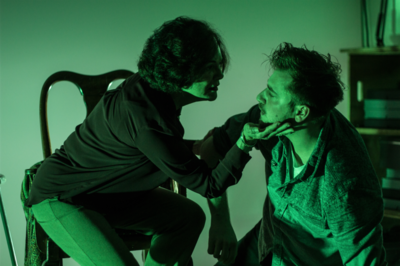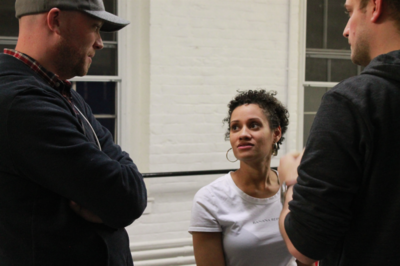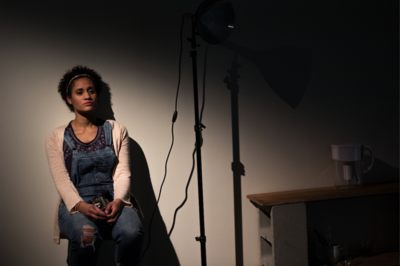A Really Creative Partnership: Company One and Matter & Light

Kippy Goldfarb and Aleksandr Portenko in Really. Photo: Paul Fox
By Olivia J. Kiers
Approaching the many philosophical questions attached to art is challenging, and responses that avoid both platitudes and obtuse rhetoric are all too rare, even among those who’ve mastered art theory. This is why Jackie Sibblies Drury’s play Really, currently being performed (through March 4) by Company One Theatre at Matter & Light Fine Art in Boston’s SoWa district, is an impressive accomplishment. Drury’s themes are prompted by 20th-century theorists of photography, including Susan Sontag, whose essay collection On Photography Drury quotes at the head of the script: “Photographs alter and enlarge our notions of what is worth looking at and what we have the right to observe.” Like Sontag, Drury examines art’s role in creating a perceived truth. Like Roland Barthes, the French theorist whose essay Camera Lucida she also quotes, Drury ponders how photography can reshape memory, especially of the departed.
“Really is delicate, intimate and meditative theater,” says the play’s director Shawn LaCount. Centering on the un-named mother and girlfriend of Calvin, a recently deceased, brilliant young photographer, the play follows its characters in current time as well as through memories evoked through photography. “It’s both grounded and dreamlike,” says LaCount. “[Drury] is a world-class playwright, relatively young in her career… Her plays are dangerous, exciting and socially motivated. Issues of gender, class, race and power are at play here. Creating a world that is as airy as mist, but pressurized and combustible is a truly fun challenge.”

Director Shawn LaCount works with actors Rachel Cognata, Aleksandr Portenko at Really rehearsal. Photo: Susanna Jackson
Actors Rachel Cognata (Girlfriend), Kippy Goldfarb (Mother) and Alex Portenko (Calvin) use Really’s long pauses and fresh language to build intense discussions on art (and the art of relationships) within the context of a portrait session. If the conversations sound sophomoric at times, it is because Drury has crafted characters that are limited by the scope of their own experiences. Drury does not preach to us about art. She does not provide conclusions that can be easily extracted from her characters’ egos and insecurities. Yet, she does weave argument and passion in an excellent parallel evocation of grieving and the creative process—life and death intertwined.
Those who obtain a ticket to this particular staging of Really are in for a special level of nuance. “As soon as we programmed the play,” says LaCount, “we knew we wanted to produce it in a non-theatrical space. We were intent on finding a space that was intimate, visually focused and one that possessed a different kind of energy for a gathering of people than a theatre does.” It won’t be the first such production for the company, since unusual venues are its calling card this season, with non-traditional stagings in the Museum of Fine Arts and the Boston Public Library. Ian Corbin, director of Matter & Light, is delighted to be in such venerable company. “Company One has a young energy. They are very daring in their work, and we are willing to be daring with them,” he explains. “Art, music and theater should talk to one another. For us to host this conversation is exciting.”
The gallery is contributing an exhibition—also titled Really—to accompany the run. Since the entire space is converted into stage, backstage and seating, all gallery walls are integrated into the play itself, helping to set the scene of a “lived-in but well-curated artist’s loft,” as Corbin summarizes it. “There is great understanding and good feeling between our two groups,” he continues. “We never clashed in our vision of what this play, in this space, could be, and we are trying hard to take it to a truly excellent artistic level.”

Rachel Cognata in Really. Photo: Paul Fox
SoWa, a contemporary art hotspot, feels ripe for this level of collaboration and risk. One could argue there’s no better play than Really to lead the way. The artist’s studios crowding the upper floors of 450 Harrison Avenue reflect Really’s imaginary space, and the art-making on stage is occuring throughout the neighborhood in real life, real time, every day. SoWa already has a strong heartbeat; this performance amplifies it.
“This play is the architecture of a snapshot,” states Drury. “The Silences, Pauses, Unfinished Sentences, Interruptions, and the Sounds of Pictures Being Taken are key components to the structural integrity of the piece.” Having devoted just over an hour to Really’s pauses and startling shutter clicks, audiences would do well to listen to the deceptive hush of SoWa as they walk out into the night. Who knows what art is in the works in this neighborhood, what looming questions being asked, and what inquiries pursued?
